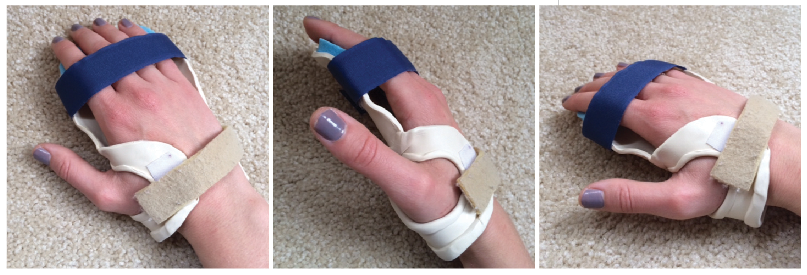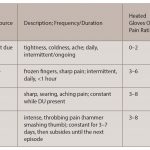In another study, the researchers surveyed 27 people with scleroderma to ascertain common work limitations.11 The two leading complaints were working with keyboards (88% of respondents) and discomfort with the type of chair used (85% of respondents). Due to limited mobility and dexterity of the hands, keyboard typing can pose a problem, and stiff, swollen hands make typing accuracy difficult. Ergonomic keyboards are recommended to ease pain, but some patients report little effectiveness with adaptive keyboards.

Figures 2A, B & C: Resting splints for the wrist and fingers used to prevent contractures.
Case Study
A 46-year-old female presented to her primary care physician (PCP) in May 2005, and subsequently to a rheumatologist, after she noticed stiffening in her right hand. The diagnosis of early scleroderma was made based upon clinical findings of hand puffiness and abnormal serologic studies.4 She was subsequently referred to physical therapy. Her main complaints were stiffness in her hands, wrist, arms, neck and shoulders. The overall stiffness was interfering with her everyday life, especially overhead activities, such as brushing her hair and reaching behind her head. Physical therapy helped her regain her range of motion and mobility. She was discharged to a home exercise program. However, therapy was often restarted during the colder months, when the patient experienced a substantial increase in stiffness.
In March 2014, the patient went for her annual rheumatology checkup, where her physician noticed bilateral tissue thickening in the patient’s hands. An X-ray was ordered, and results confirmed acroosteolysis (see Figure 1). Because there is no cure for this condition, the patient was referred to physical and occupational therapy to address her impairments and functional limitations.
Currently, her main impairments include bilateral ulcers on her hands, for which she uses a topical agent, silver sulfadiazine to assist in healing.7 She reports that the ointment and a fabric Band-Aid generally heal the ulcers in about a week.
The patient’s decrease in range of motion of the hands and fingers makes performing ADLs and other daily tasks much more challenging. This past year, stretching equipment, such as the PowerWeb hand exerciser and the FlexBar resistance device, has been integrated to assist in maintaining her range of motion.
The patient wears custom hand splints that were made for her by an occupational therapist (see Figure 2). She wears them only at night to help prevent contractures. The hard, rigid design of the splints makes them difficult to wear all day while she is busy around the house and at work.



